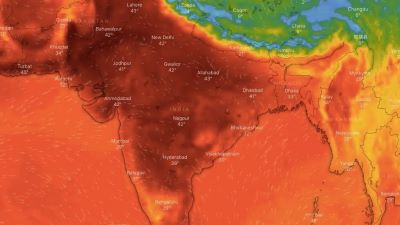Context-
As summer approaches, the India Meteorological Department (IMD) has issued early heat alerts this year, starting as early as February. Regions in northeast and western India have already experienced significantly warm temperatures (3.1-5 degrees Celsius above normal) even before the official start of summer. The IMD has forecasted further increases in maximum temperatures and the frequency of heatwave conditions in the upcoming days across eastern and southern India. This raises concerns about India's preparedness to tackle this heat hazard.
What is a heatwave?
The India Meteorological Department (IMD) defines heatwaves based on regional physiography. A heatwave is declared if the maximum temperature reaches specific thresholds: 40 degrees Celsius or higher in the plains, 37 degrees Celsius or higher in coastal areas, and 30 degrees Celsius or higher in hilly regions. Severity is determined by the departure from normal temperatures. A 'normal heatwave' occurs with a departure of 4.5-6.4 degrees Celsius, while a 'severe heatwave' is declared for greater departures. Additionally, a heatwave can be based on absolute maximum temperatures (45 degrees Celsius or higher) or severe heatwave conditions (47 degrees Celsius or higher), declared if specific criteria are met at multiple stations over consecutive days.
The definition of heatwaves varies across different regions due to diverse physiographic and climatic conditions. For instance, coastal areas may experience heatwaves at lower temperatures compared to inland regions. Understanding these variations is crucial for developing effective heat action plans (HAPs) that cater to local needs.
Local variations in heatwave impacts also include factors such as urbanization, presence of green spaces, and population density. Urban heat islands, where cities experience higher temperatures than surrounding rural areas, exacerbate heatwave effects. Therefore, HAPs must consider such localized factors to accurately assess heatwave risks and implement targeted interventions.
Heat Action Plans (HAPs) for Mitigation
Governments across India are implementing Heat Action Plans (HAPs) to address the increasing severity and frequency of heatwaves. HAPs are multi-level strategies aimed at improving preparedness and reducing adverse impacts of extreme heat events. These plans include several key recommendations:
Early Warning and Public Awareness
HAPs emphasize the use of forecasts and early warning systems to alert the public and relevant authorities about impending heatwaves. Timely communication and dissemination of information are critical to ensure that communities are prepared to face heatwave conditions.
Public education campaigns are conducted to raise awareness about heat-related risks and appropriate preventive measures. These campaigns target vulnerable populations, including the elderly, children, and outdoor workers, to educate them on recognizing heat-related illnesses and taking necessary precautions.
Infrastructure and Healthcare Provision
Construction of heat shelters and cooling centers provides immediate relief during heatwaves, offering a safe space for individuals to escape extreme temperatures. These facilities are strategically located in areas with high population density and vulnerability.
Ensuring hospitals are equipped with necessary supplies and trained staff to manage heat-related illnesses is a priority in HAPs. Healthcare workers receive specialized training to identify and treat heat-related ailments promptly, reducing the burden on healthcare systems during heatwave events.
Long-Term Adaptation Measures
Encouraging urban planning strategies like tree planting and cool roofing technologies helps mitigate urban heat island effects. Planting trees and using reflective roofing materials can reduce ambient temperatures, enhancing overall comfort and reducing energy consumption.
Advocating for the adoption of heat-resistant building materials in construction reduces indoor temperatures, making dwellings more comfortable during heatwaves. Long-term adaptation measures are essential for building climate-resilient communities that can withstand the impacts of extreme heat.
Stakeholder Collaboration
Coordination among government agencies, healthcare providers, community organizations, and emergency services ensures an effective response and recovery framework during heatwave events. Interagency collaboration facilitates resource mobilization and efficient service delivery to affected populations.
Challenges and Special Interventions for Vulnerable Communities
Despite the efforts outlined in HAPs, several challenges hinder their effectiveness, particularly in addressing the needs of vulnerable populations:
Local Context and Regional Variations
The definition and impact of heatwaves vary across regions due to factors like urbanization, humidity, and proximity to water bodies. HAPs need to account for regional variations by developing localized heatwave thresholds and comprehensive heat index measures.
Inconsistencies in vulnerability assessments across different HAPs highlight the need for standardized methods that account for regional nuances. Transitioning to robust climate risk assessments and hotspot mapping can better identify areas and populations at high risk, guiding targeted interventions.
Targeted Interventions
Vulnerable populations such as low-income communities, children, and the elderly require tailored interventions based on local socio-economic factors. Specific strategies are needed to support informal workers during heatwaves without jeopardizing their livelihoods.
Enhancing Effectiveness and Long-Term Sustainability
To improve the effectiveness and long-term sustainability of HAPs:
Integrated Planning and Funding
● Integrate HAPs with broader urban resilience and climate adaptation plans to optimize resource allocation and ensure long-term sustainability.
● Facilitate dialogue between governments, civil society organizations, and worker unions to develop financial mechanisms supporting vulnerable populations during heatwaves.
Nature-Based Solutions
● Expand focus beyond infrastructure measures like cool roofs to include nature-based solutions such as green and blue spaces.
● Prioritize planning for nature-based interventions in heat hotspot areas to enhance the resilience of vulnerable communities.
Conclusion
In conclusion, while Heat Action Plans (HAPs) have laid a strong foundation for addressing heat waves in India, there is a critical need for tailored interventions, localized strategies, and integrated approaches to effectively protect vulnerable populations and enhance urban resilience against the growing threat of extreme heat events. Comprehensive planning, stakeholder engagement, and continuous evaluation are essential for improving the effectiveness and long-term sustainability of HAPs across diverse regions in India.
|
Probable Questions for UPSC Mains Exam- 1. How does the India Meteorological Department (IMD) define a heatwave, and what factors influence the variation in heatwave thresholds across different regions of India? ( 10 Marks, 150 Words) 2. What are the key components of Heat Action Plans (HAPs) in India, and how do they aim to mitigate the adverse impacts of heat waves, especially on vulnerable populations? ( 15 Marks, 250 Words) |
Source- The Hindu







